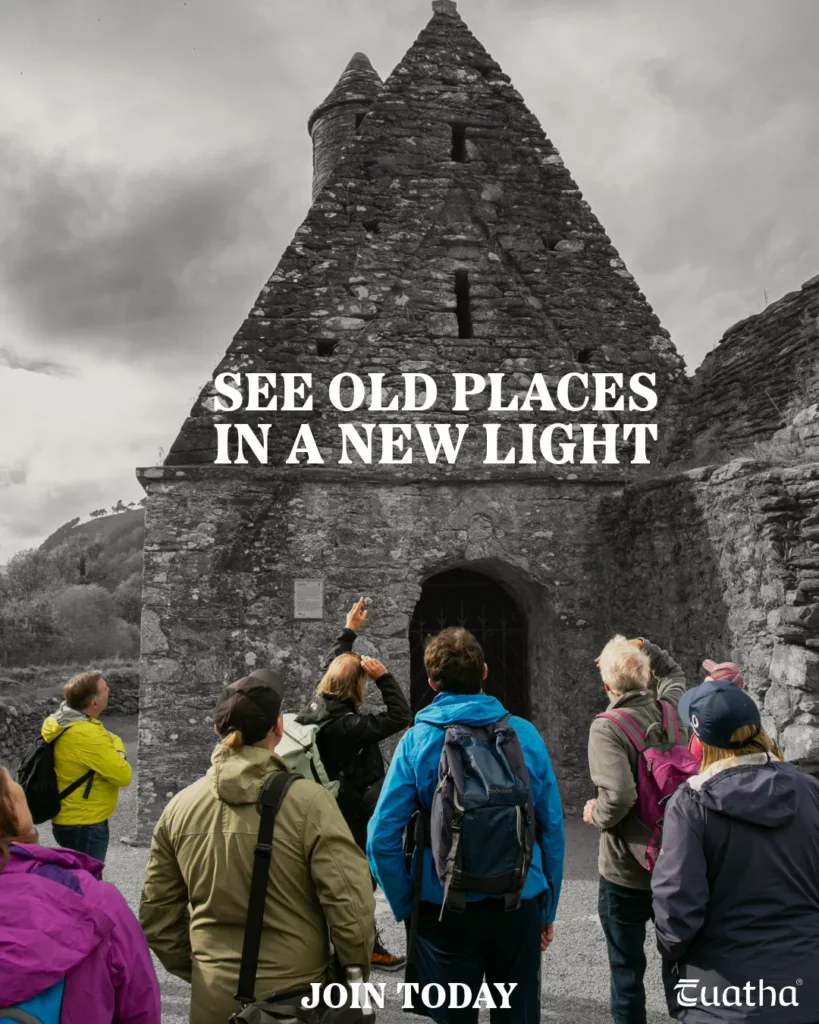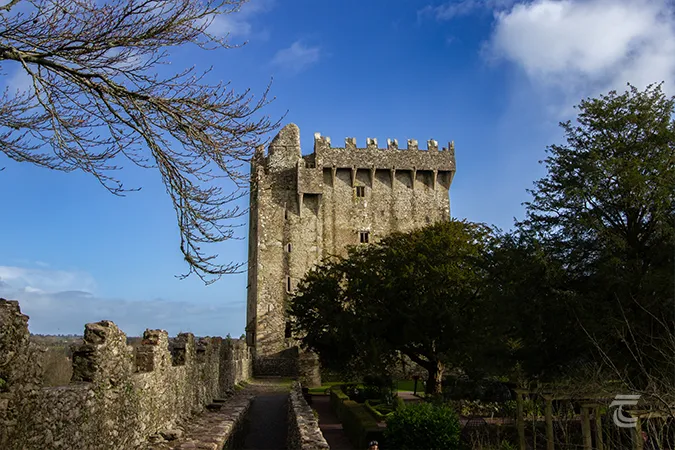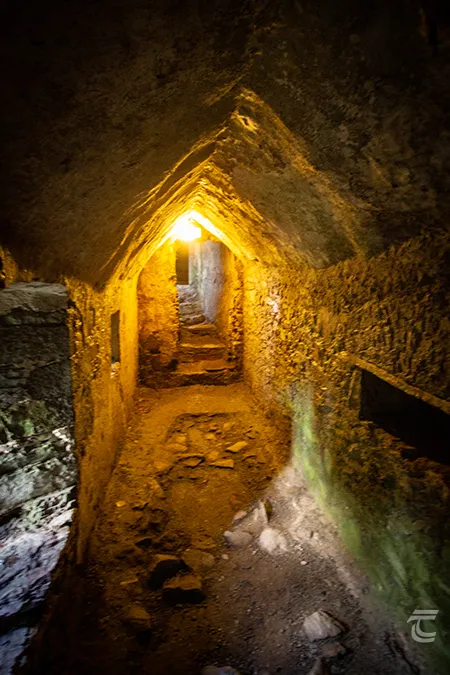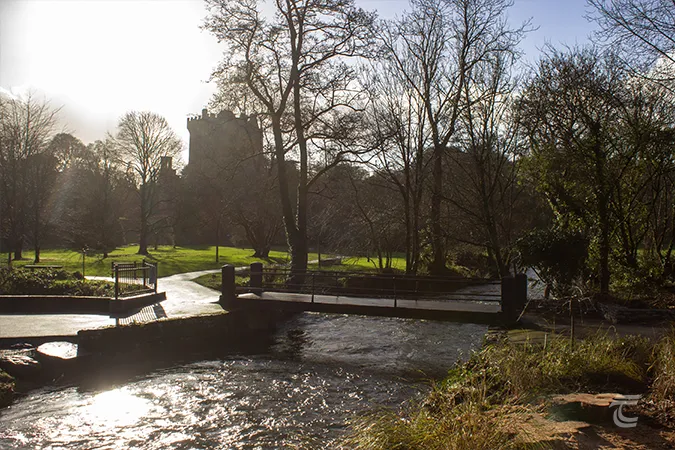Blarney Castle
Blarney Castle has become one of Ireland’s most visited heritage sites. The castle is a late medieval tower house with a five-storey extension that was was added in the late 16th or early 17th century. The castle is built on a stony limestone outcrop overlooking the confluence of the Martin and Blarney Rivers. It is thought that it was first built by Eoghan MacTaidhg, or his brother Cormac Láidir MacTaidhg, in the 1480s to protect his lands. The castle was the seat of the powerful MacTaidhg (MacCarthy) family who were Lords of Muskerry, one of the leading families of medieval Ireland, and Cormac Láidir was a prolific builder who was thought to have also founded Kilcrea Friary and Kilcrea Castle. He was contemporarily described in the Annals of the Four Masters:
‘Cormac, the son of Teige, son of Cormac Oge MacCarthy, Lord of Muskerry, a comely-shaped, bright countenanced man, who possessed most white washed edifices, fine built castles, and hereditary seats of any of the descendants of Eoghan More.’
It is very large in comparison to most Irish tower houses, and incorporates parts of an earlier castle. There are few floors remaining inside the tower, but it is still possible to make out a chapel, the banqueting hall, and a solar or ‘family room’ with a large fireplace with fine cut stone surrounds and mantle. This room also has traces of early 17th-century plasterwork, the remains of a frieze that would once have decorated the walls of this room. The castle we see today would have looked remarkably different back in its heyday. Instead of somewhat drab grey and brown stone, the castle was covered with lime plaster, bound together with horsehair and painted white.
For practical information about visiting this site Click Here
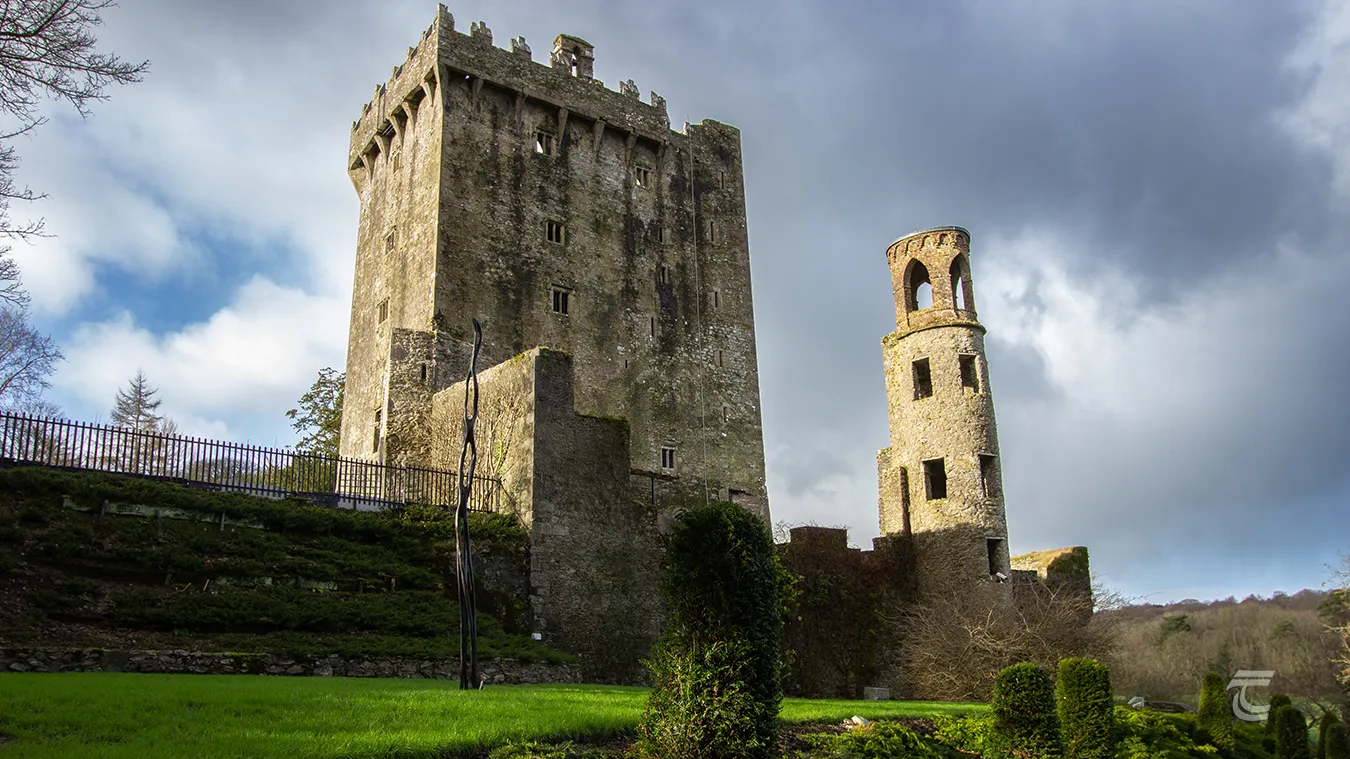
Blarney Castle viewed from the Gardens • Cork
The Legend of the Blarney Stone
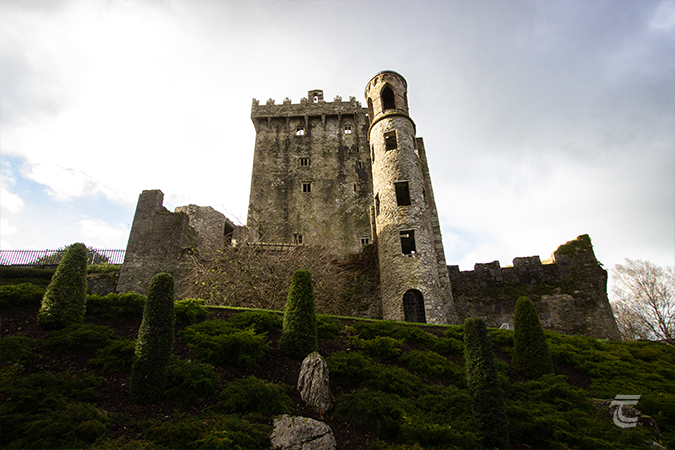
Blarney Castle • Cork
The castle was described in the Pacata Hibernia around a century after it was constructed:
‘…his castle of Blarney…is one of the largest and strongest castles within the province of Munster….seated upon a main rock, so that it is free from mining, the wall being eighteen feet thick and well flanked at each corner to the best advantage.’
Pacata Hibernia was published in c.1633 by Sir Thomas Stafford, who was a secretary to the Elizabethan President of Munster Sir George Carew who played an important role in the English campaigns against the Earl of Tyrone at the end of the 16th century. The document provided a contemporary account of affairs in Ireland during the latter stages of the Nine Years War, as well as details on the conduct of the campaign in Munster.
As well as providing the description of the castle quoted above, it also described a failed attempt by the English to seize Blarney Castle by subterfuge. Carew ordered Sir Charles Wilmot and Captain Roger Harvey to pretend to hunt deer near the castle, accompanied by a personal guard of twenty four soldiers led by a sergeant. They were to appear hot and weary from the hunt, and to call at the castle for refreshments. When they were admitted inside for food and drink in accordance to traditional Gaelic hospitality, they planned to seize the castle by force. However when they called they found the master of the house away, and the servants refused to admit anyone in the absence of their master. Perhaps the disappointed English soldiers should have tried to kiss the Blarney stone, though it is doubtful that the wary servants would have obliged.
The term ‘blarney’ meaning to charm, flatter, persuade and cajole is derived from Cormac MacCarthy of Blarney Castle. In 1602 he managed to avoid the confiscation of his lands by English Crown by sheer force of persuasion, flattery and eloquence. He cajoled Sir George Carew (Lord of Munster under Elizabeth I) so volubly and determinedly that he was permitted to keep his lands. Queen Elizabeth is supposed to have declared: ‘This is all Blarney; what he says he never means.’
Visitors can be bestowed with the same eloquence by kissing the Blarney Stone. The stone is set high on the inside wall of the tower, and whosoever kisses it is said to be granted ‘sweet persuasive, wheedling eloquence’. The legend of the Blarney Stone appears to derive from a 19th century source, The Reliques of Father Prout. This was said to be the pseudonym for the Reverend Francis Sylvester Mahony, a priest in Watergrasshill, Cork, who died in 1866. (For source see this article by Kate Hamlyn in the Irish Arts Review)
‘…There is a stone there
that whoever kisses
Oh! He never misses
To grow eloquent.
‘Tis he may clamber
To a lady’s chamber
Or become a Member
Of Parliament.
A clever spouter
He’ll sure turn out, or
An out and outer
To be let alone.
Don’t hope to hinder him
Sure he’s a pilgrim
From the Blarney Stone’

Blarney Castle • Cork
Blarney Castle was captured by Cromwell’s forces in 1646. It was later restored to the MacCarthy family, before it was finally confiscated following the Williamite Wars of the 1690s. The castle and lands were granted to the Jeffeyes family before it passed to the Colthurst family in 1846, who remain the owners to this day.
Today the castle is one of our most visited monuments, and there is a lot to enjoy here. There are some 60 acres of gardens and parkland to explore surrounding the castle, including the ominous ‘Poison Garden’, and the extensive castle itself has many features to discover.
The castle was described in the Pacata Hibernia around a century after it was constructed:
‘…his castle of Blarney…is one of the largest and strongest castles within the province of Munster….seated upon a main rock, so that it is free from mining, the wall being eighteen feet thick and well flanked at each corner to the best advantage.’
Pacata Hibernia was published in c.1633 by Sir Thomas Stafford, who was a secretary to the Elizabethan President of Munster Sir George Carew who played an important role in the English campaigns against the Earl of Tyrone at the end of the 16th century. The document provided a contemporary account of affairs in Ireland during the latter stages of the Nine Years War, as well as details on the conduct of the campaign in Munster.
As well as providing the description of the castle quoted above, it also described a failed attempt by the English to seize Blarney Castle by subterfuge. Carew ordered Sir Charles Wilmot and Captain Roger Harvey to pretend to hunt deer near the castle, accompanied by a personal guard of twenty four soldiers led by a sergeant. They were to appear hot and weary from the hunt, and to call at the castle for refreshments. When they were admitted inside for food and drink in accordance to traditional Gaelic hospitality, they planned to seize the castle by force. However when they called they found the master of the house away, and the servants refused to admit anyone in the absence of their master. Perhaps the disappointed English soldiers should have tried to kiss the Blarney stone, though it is doubtful that the wary servants would have obliged.
The term ‘blarney’ meaning to charm, flatter, persuade and cajole is derived from Cormac MacCarthy of Blarney Castle. In 1602 he managed to avoid the confiscation of his lands by English Crown by sheer force of persuasion, flattery and eloquence. He cajoled Sir George Carew (Lord of Munster under Elizabeth I) so volubly and determinedly that he was permitted to keep his lands. Queen Elizabeth is supposed to have declared: ‘This is all Blarney; what he says he never means.’
Visitors can be bestowed with the same eloquence by kissing the Blarney Stone. The stone is set high on the inside wall of the tower, and whosoever kisses it is said to be granted ‘sweet persuasive, wheedling eloquence’. The legend of the Blarney Stone appears to derive from a 19th century source, The Reliques of Father Prout. This was said to be the pseudonym for the Reverend Francis Sylvester Mahony, a priest in Watergrasshill, Cork, who died in 1866. (For source see this article by Kate Hamlyn in the Irish Arts Review)
‘…There is a stone there
that whoever kisses
Oh! He never misses
To grow eloquent.
‘Tis he may clamber
To a lady’s chamber
Or become a Member
Of Parliament.
A clever spouter
He’ll sure turn out, or
An out and outer
To be let alone.
Don’t hope to hinder him
Sure he’s a pilgrim
From the Blarney Stone’

Blarney Castle • Cork
Blarney Castle was captured by Cromwell’s forces in 1646. It was later restored to the MacCarthy family, before it was finally confiscated following the Williamite Wars of the 1690s. The castle and lands were granted to the Jeffeyes family before it passed to the Colthurst family in 1846, who remain the owners to this day.
Today the castle is one of our most visited monuments, and there is a lot to enjoy here. There are some 60 acres of gardens and parkland to explore surrounding the castle, including the ominous ‘Poison Garden’, and the extensive castle itself has many features to discover.
Upper left: the path to the castle through the gardens • Lower left: the water gardens • Right: a passageway in the castle
Top: the path to the castle through the gardens • Middle: a passageway in the castle • Bottom: the water gardens
Blarney Castle Visitor Information
One of Ireland’s most popular visitor attractions, beyond the Blarney this is a fine towerhouse with many interesting features to explore.
